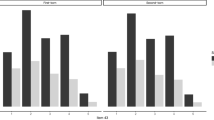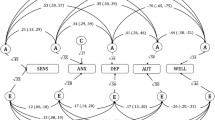Abstract
We estimated the genetic and environmental components of variation in perceived intensity and pleasantness of androstenone, an odorous compound showing specific anosmia, by modeling twin data from Finland, Denmark, the UK, and Australia. The pooled data comprised 917 twin individuals (338 are male and 579 are female; aged from 10 to 83years) including 126 complete monozygous and 264 dizygous twin pairs as well as 137 twin individuals without their co-twin. They rated intensity and pleasantness of androstenone and citronellal (control) odors using nine categories. Additive genetic effects (heritability) contributed 28 and 21% to the variation in the perceived intensity and pleasantness of androstenone, respectively, but negligibly to variations in citronellal perception. A strong genetic correlation existed between the intensity and pleasantness of androstenone, whereas the environmental correlation was negligible. These results suggest that both intensity and pleasantness of androstenone are moderately influenced by genetic factors and that the traits are modified by an overlapping set of genes.





Similar content being viewed by others
References
Boulkroune N, Wang L, March A, Walker N, Jacob TJC (2007) Repetitive olfactory exposure to the biologically significant steroid androstadienone causes a hedonic shift and gender dimorphic changes in olfactory-evoked potentials. Neuropsychopharmacology 32(8):1822–1829
Boyle JA, Lundström JN, Knecht M , Jones-Gotman M, Schaal B, Hummel T (2006) On the trigeminal percept of Androstenone and its implications on the rate of specific anosmia. J Neurobiol 66(13):1501–1510
Bremner EA, Mainland JD, Khan RM, Sobel N (2003) The prevalence of androstenone anosmia. Chem Senses 28(5):423–432
Dalton P, Doolittle N, Breslin PAS (2002) Gender-specific induction of enhanced sensitivity to odors. Nat Neurosci 5(3):199–200
Dorries KM, Schmidt HJ, Beauchamp GK, Wysocki CJ (1989) Changes in sensitivity to the odor of androstenone during adolescence. Dev Psychobiol 225(4):23–435
Dorries KM, Adkins-Regan E, Halpern BP (1995) Olfactory sensitivity to the pheromone, androstenone, is sexually dimorphic in the pig. Physiol Behav 57(2):255–259
Gross-Isseroff R, Ophir D, Bartana A, Voet H, Lancet D (1992) Evidence for genetic determination in human twins of olfactory thresholds for a standard odorant. Neurosci Lett 141(1):115–118
Kaprio J, Pulkkinen L, Rose R (2002) Genetic and environmental factors in health-related behaviors: studies on Finnish twins and twin families. Twin Res 5(5):366–371
Kaprio J (2006) Twin studies in Finland 2006. Twin Res Hum Genet 9(6):772–777
Keller A, Zhuang H, Chi Q, Vosshall LB, Matsunami H (2007) Genetic variation in a human odorant receptor alters odour perception. Nature 449:468–472
Knaapila A, Keskitalo K, Kallela M, Wessman M, Sammalisto S, Hiekkalinna T, Palotie A, Peltonen L, Tuorila H, Perola M (2007) Genetic component of identification, intensity and pleasantness of odours: a Finnish family study. Eur J Hum Genet 15(5):596–602
Labows JN, Wysocki CJ (1984) Individual differences in odor perception. Perfum Flavor 9(1):21–22, 24-26
Laska M, Wieser A, Salazar LTH (2005) Olfactory responsiveness to two odorous steroids in three species of nonhuman primates. Chem Senses 30(6):505–511
Neale MC, Cardon LR (1992) Methodology for Genetic Studies of Twins and Families. Kluwer, Dordrecht, The Netherlands
Neale MC, Boker SM, Xie G, Maes HH (2003) Mx: statistical modeling, 6th ednVCU, Department of Psychiatry. Richmond, VA, USA
Pause BM, Ferstl R, Fehm-Wolfsdorf G (1998) Personality and olfactory sensitivity. J Res Pers 32(4):510–518
Pause BM (2004) Are androgen steroids acting as pheromones in humans? Physiol Behav 83(1):21–29
Pierce JD, Cohen AB, Ulrich PM (2004) Responsivity to two odorants, androstenone and amyl acetate, and the affective impact of odors on interpersonal relationships. J Comp Psychol 118(1):14–19
Skytthe A, Kyvik K, Holm NV, Vaupel JW, Christensen K (2002) The Danish twin registry: 127 birth cohorts of twins. Twin Res 5(5):352–357
Skytthe A, Kyvik K, Bathum L, Holm N, Vaupel JW, Christensen K (2006) The Danish twin registry in the new millennium. Twin Res Hum Genet 9(6):763–771
Spector TD, Williams MK (2006) The UK Adult Twin Registry (TwinsUK). Twin Res Hum Genet 9(6):899–906
Stowers L, Marton TF (2005) What is pheromone? Mammalian pheromones reconsidered. Neuron 46(5):699–702
Wright MJ, Martin NG (2004) Brisbane adolescent twin study: outline of study methods and research projects. Aust J Psychol. 56(2):65–78
Wyart C, Webster WW, Chen JH, Wilson SR, McClary A, Khan RM, Sobel N (2007) Smelling a single component of male sweat alters levels of cortisol in women. J Neurosci 27(6):1261–1265
Wysocki CJ, Beauchamp GK (1984) Ability to smell androstenone is genetically determined. Proc Natl Acad Sci U S A 81(15):4899–4902
Wysocki CJ, Gilbert AN (1989) National Geographic smell survey—Effects of age are heterogenous. Ann NY Acad Sci 561:12–28
Wysocki CJ, Dorries KM, Beauchamp GK (1989) Ability to perceive androstenone can be acquired by ostensibly anosmic people. Proc Natl Acad Sci U S A 86(20):7976–7978
Acknowledgments
Quest International (presently Givaudan) is thanked for sponsoring the scratch-and-sniff odor stimuli. We thank the twins for their participation in the study, as well as Jytte Duerlund, Birgit Wich, Ann Eldridge, Marlene Grace, Daniel Park, Kaisu Taskila, Johanna Kuumola, Kati Kristiansson, Mari Lehtonen, Mari Siltala, Eero Vuoksimaa, Ursula Perks, and the TRU staff for their contribution to data collection. Kevin Deegan is thanked for his helpful suggestions on language of the manuscript. The Academy of Finland [grants 206327 (HT, AK, KK) and 108297 (KS)] and the European Commission [GenomEUtwin project under the ‘Quality of Life and Management of the Living Resources’ of 5th Framework Programme (QLG2-CT-2002–01254)] are acknowledged for funding. Data collection of Finnish twins was supported by the National Institutes of Health grants AA-12502 (to RJ Rose), and by the Academy of Finland grant 205585 (JK). JK, KS, and MP are supported by the Academy of Finland Centre of Excellence in Complex Disease Genetics.
Author information
Authors and Affiliations
Corresponding author
Rights and permissions
About this article
Cite this article
Knaapila, A., Tuorila, H., Silventoinen, K. et al. Genetic and Environmental Contributions to Perceived Intensity and Pleasantness of Androstenone Odor: An International Twin Study. Chem. Percept. 1, 34–42 (2008). https://doi.org/10.1007/s12078-007-9005-x
Received:
Accepted:
Published:
Issue Date:
DOI: https://doi.org/10.1007/s12078-007-9005-x




